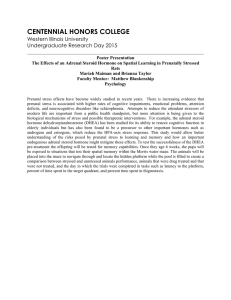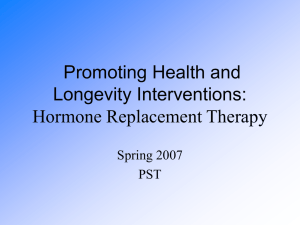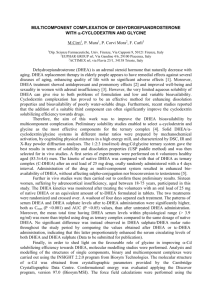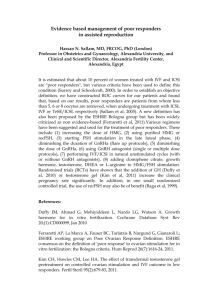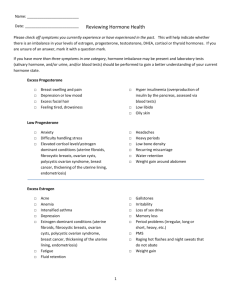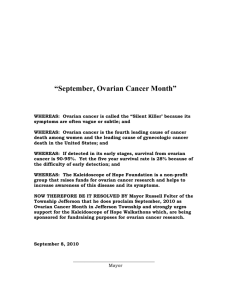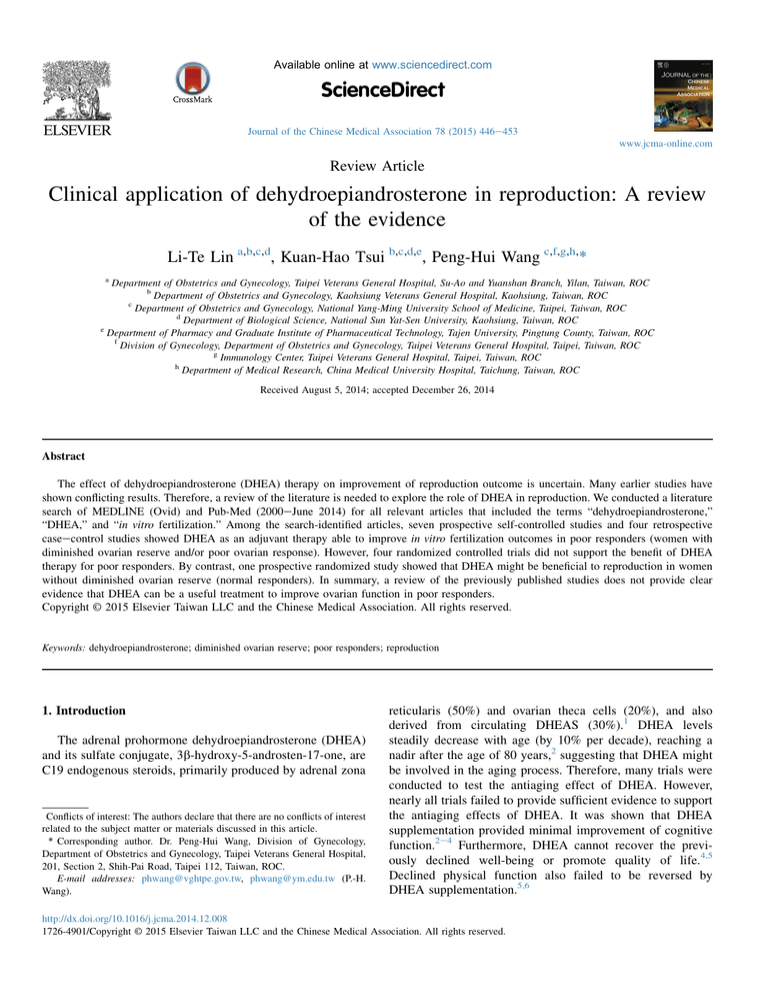
Available online at www.sciencedirect.com
ScienceDirect
Journal of the Chinese Medical Association 78 (2015) 446e453
www.jcma-online.com
Review Article
Clinical application of dehydroepiandrosterone in reproduction: A review
of the evidence
Li-Te Lin a,b,c,d, Kuan-Hao Tsui b,c,d,e, Peng-Hui Wang c,f,g,h,*
a
Department of Obstetrics and Gynecology, Taipei Veterans General Hospital, Su-Ao and Yuanshan Branch, Yilan, Taiwan, ROC
b
Department of Obstetrics and Gynecology, Kaohsiung Veterans General Hospital, Kaohsiung, Taiwan, ROC
c
Department of Obstetrics and Gynecology, National Yang-Ming University School of Medicine, Taipei, Taiwan, ROC
d
Department of Biological Science, National Sun Yat-Sen University, Kaohsiung, Taiwan, ROC
e
Department of Pharmacy and Graduate Institute of Pharmaceutical Technology, Tajen University, Pingtung County, Taiwan, ROC
f
Division of Gynecology, Department of Obstetrics and Gynecology, Taipei Veterans General Hospital, Taipei, Taiwan, ROC
g
Immunology Center, Taipei Veterans General Hospital, Taipei, Taiwan, ROC
h
Department of Medical Research, China Medical University Hospital, Taichung, Taiwan, ROC
Received August 5, 2014; accepted December 26, 2014
Abstract
The effect of dehydroepiandrosterone (DHEA) therapy on improvement of reproduction outcome is uncertain. Many earlier studies have
shown conflicting results. Therefore, a review of the literature is needed to explore the role of DHEA in reproduction. We conducted a literature
search of MEDLINE (Ovid) and Pub-Med (2000eJune 2014) for all relevant articles that included the terms “dehydroepiandrosterone,”
“DHEA,” and “in vitro fertilization.” Among the search-identified articles, seven prospective self-controlled studies and four retrospective
caseecontrol studies showed DHEA as an adjuvant therapy able to improve in vitro fertilization outcomes in poor responders (women with
diminished ovarian reserve and/or poor ovarian response). However, four randomized controlled trials did not support the benefit of DHEA
therapy for poor responders. By contrast, one prospective randomized study showed that DHEA might be beneficial to reproduction in women
without diminished ovarian reserve (normal responders). In summary, a review of the previously published studies does not provide clear
evidence that DHEA can be a useful treatment to improve ovarian function in poor responders.
Copyright © 2015 Elsevier Taiwan LLC and the Chinese Medical Association. All rights reserved.
Keywords: dehydroepiandrosterone; diminished ovarian reserve; poor responders; reproduction
1. Introduction
The adrenal prohormone dehydroepiandrosterone (DHEA)
and its sulfate conjugate, 3b-hydroxy-5-androsten-17-one, are
C19 endogenous steroids, primarily produced by adrenal zona
Conflicts of interest: The authors declare that there are no conflicts of interest
related to the subject matter or materials discussed in this article.
* Corresponding author. Dr. Peng-Hui Wang, Division of Gynecology,
Department of Obstetrics and Gynecology, Taipei Veterans General Hospital,
201, Section 2, Shih-Pai Road, Taipei 112, Taiwan, ROC.
E-mail addresses: phwang@vghtpe.gov.tw, phwang@ym.edu.tw (P.-H.
Wang).
reticularis (50%) and ovarian theca cells (20%), and also
derived from circulating DHEAS (30%).1 DHEA levels
steadily decrease with age (by 10% per decade), reaching a
nadir after the age of 80 years,2 suggesting that DHEA might
be involved in the aging process. Therefore, many trials were
conducted to test the antiaging effect of DHEA. However,
nearly all trials failed to provide sufficient evidence to support
the antiaging effects of DHEA. It was shown that DHEA
supplementation provided minimal improvement of cognitive
function.2e4 Furthermore, DHEA cannot recover the previously declined well-being or promote quality of life.4,5
Declined physical function also failed to be reversed by
DHEA supplementation.5,6
http://dx.doi.org/10.1016/j.jcma.2014.12.008
1726-4901/Copyright © 2015 Elsevier Taiwan LLC and the Chinese Medical Association. All rights reserved.
L.-T. Lin et al. / Journal of the Chinese Medical Association 78 (2015) 446e453
By contrast, the use of DHEA might be beneficial in
women with declined ovarian function, or diminished ovarian
reserve (DOR) and/or poor ovarian response (POR), and these
women were called poor responders. Since issues of subfertility is still a challenge in medicine, especially for the older
population,7 many strategies have been attempted that seek to
ameliorate the problem.8 Assisted reproductive techniques
have advanced significantly in recent years, contributing to a
significant improvement in reproduction secondary to female
tubal occlusion and/or male infertility factors.9,10 However,
women with DOR or POR, estimated to occur in 5e18% of
in vitro fertilization (IVF) cycles, present a significant challenge in assisted reproductive techniques.11 These poor responders have poor IVF outcomes with extremely low
pregnancy rates (2e4%), in spite of the use of various stimulation protocols and downregulation strategies.12 The investigation by Casson et al13 might be the first to utilize DHEA in
the assisted reproductive techniques mediated by augmenting
ovarian response. Several years later, Barad and Gleicher14
described an astonishing case with rapidly increased oocyte
production after DHEA supplementation. Thus, scientists were
interested in the study of DHEA, since it may function as an
antiaging agent to rescue DOR.13,14 Nevertheless, despite the
widespread use of DHEA as an adjuvant to IVF treatment
protocols in women with DOR and/or POR worldwide,14 two
major questions still remain unresolved. First, effectiveness of
DHEA has remained controversial, because of the lack of a
strong evidence to substantiate it. Second, the exact mechanism of DHEA in reproduction remains speculative. Therefore, in our review, we attempted to explore the effect of
DHEA on reproduction and also investigated its possible
mechanism.
2. Methods
We searched Medline (Ovid) and Pub-Med (2000eJune
2014) for case reports, case series, prospective self-controlled
studies, retrospective caseecontrol studies, and randomized
controlled trials (RCTs). The Medical Subject Headings
search terms used included the following: (1) DHEA and dehydroepiandrosterone; (2) poor response, low response, and
diminished ovarian reserve; (3) premature ovarian failure and
primary ovarian insufficiency; and (4) ovarian response,
ovarian stimulation, ovarian reserve, in vitro fertilization
(IVF), and assisted reproduction techniques.1,13e68 We
included RCTs that compared DHEA with placebo therapy in
women, published as full manuscripts in the English language.
The primary outcomes of these studies were clinical pregnancy and live birth rates, and the secondary outcomes were
ovarian reserve, oocyte/embryo yield and quality, miscarriage
rate, and aneuploidy rate. In our search, we analyzed seven
prospective self-controlled studies37e43 for poor responders,
four retrospective caseecontrol studies for poor
responders,47e50 four RCTs for poor responders,32,54e56 one
prospective randomized study for normal responders,57 and
one prospective randomized study for primary ovarian insufficiency (POI).62
447
3. Possible mechanisms
Although the underlying mechanisms of DHEA-induced
improvement of reproductive outcomes remain uncertain, it
is speculated that the effect of DHEA may be mediated by
androgen and insulin-like growth factor-1 (IGF-1).
DHEA, an essential substrate for steroidogenesis, is a
precursor of estradiol and testosterone15 and serves as a prohormone of follicular fluid testosterone during ovarian induction with exogenous gonadotrophins.16 Androgen receptors
(ARs) were detected in the ovarian stroma and granulosa cells
of the primordial follicles, and were more clearly seen in
primary follicles and more advanced-stage follicles.17e24
Perhaps, through ARs or metabolic pathways, androgens are
believed to promote recruitment and initiation of primordial
follicle growth; stimulate development of primary, preantral,
and antral follicles18; rescue follicles from atresia19; suppress
apoptosis17; and upregulate follicle-stimulating hormone
(FSH) receptor expression20,21,23 as well as IGF-1 expression.22 In granulosa cell-specific AR knockout mice, a loss of
classical genomic AR signaling in the granulosa cell brings
about subfertility, dysfunctional late follicle development,
increased follicular atresia, reduced cumulus cell (CC)
expansion, as well as ovary viability.25,26 Clinically, it has
been indicated that the androgen level decreases with
advancing female age and is lower in women with DOR, POR,
or POI.27,28 Two meta-analysis studies demonstrated that
pretreatment with transdermal testosterone was associated
with an increase in clinical pregnancy and live birth rates in
poor responders undergoing ovarian stimulation for IVF.29,30
Besides, in an experimental model of sheep ovary, DHEA
could stimulate early follicular growth during the preantral and
early antral stages, possibly mediated through modulation of
the anti-Müllerian hormone (AMH) expression and promotion
of granulosa cell proliferation.31 AMH was reported as a good
marker of ovarian reserve.69,70 In a clinical analysis, it was
proposed that DHEA supplementation may enhance the
follicular microenvironment by significantly decreasing the
follicular fluid levels of hypoxic inducible factor 1, which
represents a key molecule in the reaction of cells to
hypoxia.32,71
By contrast, in a preliminary study, oral administration of
DHEA led to a marked enhancement of serum IGF-1 concentrations.33 The ratio of IGF-1/insulin-like growth factor
binding protein-3 in serum or in the follicular fluid may be
indicative of oocyte quality and maturity.34 Furthermore, IGF1 had positive effects on embryo quality and development.35,36
4. Poor responders or women with DOR and/or POR
In 2000, Casson et al13 first postulated that using adjuvant
DHEA in poor responders would lead to an enhanced ovarian
response. A small series of five poor responders were
administered DHEA 80 mg daily for 2 months prior to
entering into their next intrauterine insemination cycle. The
peak estradiol (E2) concentrations and E2/ampoule ratio
increased in all six cycles. One of the cycles resulted in a
448
L.-T. Lin et al. / Journal of the Chinese Medical Association 78 (2015) 446e453
delivered twin pregnancy.13 In 2005, Barad and Gleicher14
reported the case of an older female (43 years) with DOR
who received serial ovulation induction with concomitant
daily self-administration of DHEA and weekly acupuncture
treatment. After nine ovulation cycles, her peak E2 was 9178
pmol/mL, leading to the retrieval of 17 oocytes, which seemed
to be a dramatic improvement.14 Later on, a number of studies
were conducted to better elucidate the effects of DHEA supplementation in poor responders.37e45
Several prospective self-controlled studies declared that
beneficial effects on reproductive outcomes37e40 and ovarian
reserve markers41e45 were found following DHEA supplementation in poor responders or women with DOR and/or
POR (Table 1)37e43. Barad and Gleicher37 proclaimed that
paired analysis of IVF cycle outcomes in 25 patients with
DOR, who underwent both pre- and post-DHEA cycles,
demonstrated significant increases in retrieval oocytes
( p < 0.05), fertilized oocytes ( p < 0.001), normal Day 3
embryos ( p ¼ 0.001), transferred embryos ( p ¼ 0.005), and
average embryo scores per oocyte ( p < 0.001) following
DHEA supplementation. The study of S€
onmezer et al38
enrolled 19 poor responders, who experienced IVF cycles
both prior to and after DHEA treatment.35 An increased
number of retrieved oocytes (4.9 ± 2.3 vs. 2.5 ± 1.6; p < 0.05),
metaphase II oocytes (4 ± 1.8 vs. 2.1 ± 1.8; p < 0.05), and topquality Day 3 embryos (1.9 ± 0.8 vs. 0.7 ± 0.6; p < 0.05) were
achieved in DHEA-treated cycles compared with those in the
preceding cycles without DHEA treatment.35 Pregnancy rates
per patient and per embryo transfer (47.4% vs. 10.5%;
p < 0.01 and 50.0% vs. 18.2%; p < 0.05) were also significantly superior in DHEA-supplemented cycles. In a recent
study, Zangmo and colleagues39 presented a prospective
cohort study of 50 poor responders, who were treated with oral
micronized DHEA daily for 4 months prior to entry into their
next IVF cycles. After treatment with DHEA, there were
significant increases in the numbers of retrieval oocytes,
metaphase II oocytes, fertilized oocytes, Grade I embryos, and
transferred embryos compared to non-DHEA treatment cycles
in both age groups ( 35 years and 36 years).39 Moreover,
Yilmaz et al41 demonstrated that when they compared the
evaluation of ovarian reserve markers in 41 DOR patients who
underwent IVF cycles both prior to and after DHEA supplementation, significant improvement was observed in Day 3
FSH level, estradiol level, antral follicle count (AFC), AMH
level, and inhibin B level ( p ¼ 0.001, 0.001, 0.002, 0.001, and
0.001, respectively,) following DHEA supplementation,
without age-related difference. Additionally, Gleicher et al46
performed a retrospective cross-sectional and longitudinal
analysis of 120 consecutive women with DOR. Fifty-five patients in a longitudinal follow-up showed a significant
improvement in AMH concentrations after DHEA supplementation over time ( p ¼ 0.002).46 Among 55 women who
had undergone IVF, those who conceived demonstrated a
significantly better AMH response following DHEA supplementation than unsuccessful patients ( p ¼ 0.001).46 Nonetheless, data from the self-controlled studies should be
interpreted with caution due to potential bias.
In addition, some retrospective caseecontrol studies
showed that DHEA supplementation was able to improve the
pregnancy rate,47,48 reduce the miscarriage rate,49 and lessen
embryo aneuploidy50 (Table 2). Barad et al47 undertook a
retrospective caseecontrol study of 190 women with DOR
who were divided into a study group (n ¼ 89; supplied with
DHEA prior to entry into their next IVF cycles) and a control
group (n ¼ 101; receiving IVF cycles without DHEA). The
cumulative clinical pregnancy rates were significantly higher
in the DHEA group than in the control group (28.4% vs.
11.9%; p < 0.05).47 Remarkably, almost half of all the pregnancies in the study group occurred spontaneously prior to the
initiation of IVF; however, even within the patients who proceeded with IVF, there was a strong trend towards higher
pregnancy rates (20.6 vs. 11.9%).47 The retrospective study of
Fusi et al48 included 38 women with DOR who received
DHEA supplementation and 24 comparable women who had
not been treated with DHEA prior to the IVF cycle, to evaluate
the spontaneous pregnancy rate during preparation for IVF.
Amazingly, the pregnancy rates (21.05% vs. 4.1%; p < 0.05)
and ongoing pregnancy rates (13.15% vs. 0%; p < 0.01)
measured prior to starting the IVF cycle were significantly
higher in the DHEA group than in the control group.48
Gleicher et al49 retroactively compared miscarriage rates in
73 DHEA-supplemented pregnancies at two independent
North American infertility centers, age-stratified, with miscarriages reported in a national United State IVF database.46
Miscarriage rates after DHEA therapy were significantly
lower at all ages, especially above the age of 35 years [odds
Table 1
Prospective self-controlled studies on the use of DHEA in poor responders.
Number
Perioda
Findings
Barad and Gleicher
25
4 mo
S€
onmezer et al38
Yilmaz et al41
Singh et al42
Hyman et al43
Zangmo et al39
19
41
30
32
50
3 mo
6 wk
4 mo
3 mo
4 mo
Poli et al40
29
8 wk
Benefits in retrieval oocytes, fertilized oocytes, normal Day 3 embryos, Day 3 embryo grade,
and transferred embryos
Benefits in retrieval oocytes, MII oocytes, embryo grade, and pregnancy rate
Benefits in ovarian reserve markers (FSH, estradiol, AFC, AMH, and inhibin B)
Benefits in ovarian reserve markers (FSH and AMH)
Benefits in AFC, retrieval oocytes, MII oocytes, and transferred embryos
Benefits in retrieval oocytes, MII oocytes, fertilized oocytes, Grade I embryos,
and transferred embryos
Benefits in retrieval oocytes and oocyte quality
Authors
37
AFC ¼ antral follicle count; AMH ¼ anti-Müllerian hormone; DHEA ¼ dehydroepiandrosterone; FSH ¼ follicle-stimulating hormone; MII ¼ metaphase II.
a
Period represents the duration for which the women received 75 mg DHEA daily.
L.-T. Lin et al. / Journal of the Chinese Medical Association 78 (2015) 446e453
449
Table 2
Retrospective caseecontrol studies of DHEA in poor responders.
Authors
Number
47
Barad et al
Gleicher et al49
Gleicher et al50
Fusi et al48
89
73
22
38
DHEA vs.
DHEA vs.
DHEA vs.
DHEA vs.
101 controls
IVF data baseb
44 controls
24 controls
Perioda
Findings
4 mo
2 mo
4e12 wk
12 wk
Benefit in cumulative pregnancy rate
Reduction in miscarriage rate
Reduction in aneuploid embryos
Benefit in spontaneous pregnancy
DHEA ¼ dehydroepiandrosterone; IVF ¼ in vitro fertilization.
a
Period represents the duration for which the women received 75 mg DHEA daily.
b
Compared to miscarriages reported in a national United States IVF database.
ratio ¼ 0.49; 95% confidence interval (CI) 0.25e0.94;
p ¼ 0.04].49 Furthermore, miscarriage rates after DHEA
supplementation were not only lower than those in an average
national IVF population but also comparable to the rates reported in general populations.49 In a 1:2 matched caseecontrol
study, 22 women with DOR, supplemented with DHEA, and
44 control patients underwent preimplantation genetic
screening of embryos during IVF cycles. DHEA supplementation was proved to have a significant reduction in the number
(2.8 ± 2.5 vs. 4.5 ± 3.1; p ¼ 0.029) and percentages
(38.2 ± 24.4% vs. 61.0 ± 22.4%; p < 0.001) of aneuploid
embryos.50 Nevertheless, the results of retrospective caseecontrol studies were also not free from bias.
According to the abovementioned studies, some people
considered DHEA as a potential intervention to rejuvenate
ovarian reserve and improve IVF outcomes for poor responders or women with DOR, but some people discounted
those results because of the lack of a strong evidence from
prospective RCTs.51,52 A meta-analysis with only three
eligible controlled studies was conducted to investigate the
efficacy of DHEA as an adjuvant to improve IVF outcomes in
women with DOR. There was no significant difference in the
clinical pregnancy rate and miscarriage rates between women
pretreated with DHEA and those without DHEA pretreatment
(relative risk 1.87, 95% CI 0.96e3.64; p ¼ 0.07 and relative
risk 0.59, 95% CI 0.21e1.65; p ¼ 0.32, respectively).53
Therefore, the authors concluded that there remain insufficient data to support a beneficial role of DHEA as an adjuvant
to IVF cycle, and well-designed RCTs are imperative to support the use of DHEA in standard practice for poor responders.53 Unfortunately, such studies are, practically
speaking, difficult to perform, since patients with DOR always
have limited time to conceive and are unwilling to join a
randomized trial in which they may be assigned to a placebo
group. Indeed, two registered prospective, placebo RCTs, one
in the United States and the other in Europe, had to be
abandoned because of insufficient enrollment of women,
willing to be randomized to placebo (Gleicher et al, unpublished data, 2006; Barad et al, unpublished data, 2007).
Encouragingly, the first prospective RCT was published by
Wiser et al.54 Their trial enrolled 33 women with significant
DOR, 17 in the DHEA group and 16 in the control group.54 In
the DHEA group, 17 patients completed the first IVF cycle
and nine completed a second cycle, for a total of 26 cycles;
among the control group, 16 patients completed the first cycle
and nine completed the second cycle, for a total of 25 cycles.54
In the DHEA group, embryo quality improved significantly in
the second cycle, compared to the first cycle. A significantly
higher live birth rate was found in the total cycles in the
DHEA group than in the control group (23.1% vs. 4.0%;
p ¼ 0.05), but not in the first cycle (17.6% vs. 6%; p ¼ 0.2).54
Unfortunately, Wiser et al's54 study was criticized for severe
methodological and statistical problems as well as many
limitations and weaknesses,51,52 leading us to discredit the
data. Recently, three updated, randomized, prospective,
controlled studies were published, but failed to confirm the
benefits of DHEA in poor responders or DOR patients31,55,56
(Table 3).32,54e57,62 Artini et al32 selected 24 patients diagnosed as poor responders, with 12 in the DHEA group and 12
in the control group in the RCT. The total numbers of retrieval
oocytes, fertilized oocytes, good-quality embryos, transferred
embryos, and clinical pregnancies per cycle were comparable
between the two groups.32 A randomized, double-blind, placebo-controlled study by Yeung et al55 included 32 women
Table 3
Randomized controlled trials of DHEA on reproduction.
Authors
Number
Perioda
Poor responders
Wiser et alb,54
33
6 wk
Artini et al32
24
3 mo
Yeung et al55
32
12 wk
208
12 wk
Kara et al56
Normal responders
Tartagni et al57
52
8 wk
Primary ovarian insufficiency or premature ovarian failure
Yeung et al62
22
16 wk
Findings
Benefits in embryo quality and live birth rate
No benefits in IVF outcomes
No benefits in ovarian response markers, ovarian response, or IVF outcomes
No benefits in IVF outcomes
Benefits in IVF outcomes
Benefits in higher AFC and ovarian volume, but no benefits in serum AMH and FSH levels
AFC ¼ antral follicle count; AMH ¼ anti-Müllerian hormone; DHEA ¼ dehydroepiandrosterone; FSH ¼ follicle-stimulating hormone; IVF ¼ in vitro fertilization.
a
Period represents the duration for which the women received 75 mg DHEA daily.
b
The study had been criticized because of severe methodological and statistical problems.
450
L.-T. Lin et al. / Journal of the Chinese Medical Association 78 (2015) 446e453
with POR, randomized to the DHEA group (n ¼ 16) or placebo group (n ¼ 16). DHEA supplementation indeed resulted
in statistically significantly higher serum DHEAS level, free
androgen index, and follicular DHEAS level, but no statistically significant differences in the ovarian response markers
(AFC, AMH, or FSH) and IVF outcomes (pregnancy and live
birth rates) were found between the two groups.55 Kara et al56
presented a randomized, prospective controlled trial that
enrolled 208 DOR women, 104 cases in the DHEA group and
104 in the control group. The results failed to show that DHEA
as an adjuvant enhances IVF outcomes (retrieval oocytes,
metaphase II oocytes, fertilization rate, and clinical pregnancy
rate) in women with DOR.56
In summary, our review of case reports, case series,
prospective self-controlled studies, and retrospective
caseecontrol studies reported potential beneficial effects of
DHEA supplementation on reproductive outcomes and ovarian
reserve in poor responders or women with DOR and/or POR;
however, a meta-analysis and seven prospective RCTs failed to
verify the benefit. The role of DHEA in poor responders or
women with DOR and/or POR seemed to be inconclusive and
questionable after extensive reviews. Consequently, welldesigned large-scale prospective RCTs are necessary to
clarify whether or not DHEA has any beneficial effect on
reproduction.
5. Normal responder
Casson et al13 deemed that DHEA treatment, applied for
normal patients, can decrease the dose of gonadotrophin.
Gleicher et al49 suggested that DHEA supplementation may be
used in a normal fertile population above 35 years of age to
diminish the miscarriage rate. However, there were no related
published data until recently. Tartagni et al57 submitted a
double-blind, randomized, placebo-controlled study of 52
infertile patients with normal ovarian reserve, divided into the
DHEA and control groups. Patients in the DHEA group had a
significantly higher live birth rate ( p < 0.05) and a lower
miscarriage rate than those in the control group ( p < 0.05)57
(Table 3). Further research is essential to reinforce the result.
6. POI or premature ovarian failure
POI is a situation that represents impaired ovarian function
on a continuum with intermittent ovulation; its diagnosis
should be confirmed by obtaining two FSH levels in the
menopausal range at least 1 month apart as well as amenorrhea
for at least 4 months prior to the age of 40 years.58 Up to 50%
of women with POI have varying degrees of residual ovarian
function, and it is estimated that approximately 5e10% can
conceive spontaneously.59 Nonetheless, POI usually gives rise
to eventual premature ovarian failure, characterized by permanent loss of ovarian function.55
A case series of five patients with premature ovarian failure
(mean FSH of 65.8 mIU/mL and mean E2 of 26.4 pg/mL),
receiving 50e75 mg DHEA supplementation for 2e6 months,
revealed dramatic improvement of ovarian reserve (mean FSH
of 15.28 mIU/mL and mean E2 of 56.6 pg/mL), and all achieved pregnancy spontaneously or after intrauterine tuboperitoneal insemination.60 Gleicher et al61 performed a
retrospective caseecontrol study of 27 consecutive IVF cycles
in women with POI, eight cases in the DHEA group and 19 in
the control group, undergoing preimplantation genetic diagnosis. The results suggest that DHEA treatment increases the
number of euploid embryos available for embryo transfer in
women with POI.61 A randomized, double-blinded, placebocontrolled study by Yeung et al62 enrolled 22 women with
unexplained POI, randomized into a DHEA group (n ¼ 10)
and a placebo group (n ¼ 12). The AFC ( p ¼ 0.034) and total
ovarian volume ( p ¼ 0.033) were significantly higher in the
DHEA group than in the control group, but no significant
change in serum AMH and FSH levels had been detected
throughout the study62 (Table 3). Further studies are needed to
confirm this result.
7. Side effects
Women with DHEA supplementation may experience
possible androgenic effects such as oily skin, acne, deepening
of the voice, mild hair loss, and facial or body hair growth47,63;
however, some feel energized, and report increased libido and
an improved sense of well-being.37,46,47 In published studies,
the adverse effects of DHEA appear to be minimal with the
therapeutic dose of 75 mg per day.63 However, the long-term
effects of DHEA supplementation remain unknown. Now
that first-trimester placenta is capable of converting cholesterol to pregnenolone to DHEA,64 exposure to DHEA in early
pregnancy should be assured. Nevertheless, another safety
issue of substantial concern is that DHEA may increase the
risk of estrogen- or androgen-dependent malignancies. It has
been substantiated that circulating estrogens and androgens are
positively associated with the risk for breast cancer in premenopausal women.65,66
8. Further work
Of significant importance is the need for well-designed and
large-scale prospective RCTs. Currently, several trials are
under way to explore the potential effects of DHEA on ovarian
response and reproductive outcomes in poor responders undergoing IVF cycles and in patients with POI (see http://
clinicaltrials.gov). Moreover, the optimal dose and duration
of DHEA supplementation were still uncertain, although the
majority of the published studies used DHEA at a dose of
75 mg daily for 6e16 weeks. In an experimental model of rats,
Ikeda et al67 found that medium-term DHEA administration
increases the number of follicles and enhances production of
AMH, which may provide local negative feedback to folliculogenesis and interfere with growth of early follicle.
Accordingly, long-term DHEA administration leads to a
decrease in healthy follicles and an increase in atretic follicles.
Further investigation is necessary to establish a standard dose
and duration of DHEA administration, as well as ascertaining
the maximal dose and duration.
L.-T. Lin et al. / Journal of the Chinese Medical Association 78 (2015) 446e453
By contrast, various definitions of poor response or DOR
were noted in different studies, bringing about comparison difficulties since there was no standard definition of DOR or poor
response prior to the Bologna criteria.68 In 2011, the European
Society of Human Reproduction and Embryology campus
workshop in Bologna standardized the definition of abnormal
ovarian reserve and poor response.68 Hence, further research is
suggested to enroll patients according to the Bologna criteria.
Furthermore, in recent years, analysis of gene expression in
CCs is considered a noninvasive approach to identify oocytes
with a high potential, to achieve better IVF outcomes. Recent
studies have reported that the expression of candidate genes in
CCs have the potential to serve as a marker of oocyte maturation and competence, embryo development and quality,
pregnancy outcome, and live birth.72e74 Thus, investigation of
the effect of DHEA on gene expression of CCs may be a good
idea to identify the exact mechanisms of DHEA in follicular
microenvironment.45 In our previous study, we found that
DHEA supplementation might influence gene expression of
CCs in women with POR, and these genes were involved in
extracellular matrix formation, cell development, differentiation, and apoptosis regulation. Additionally, changes of the
abovementioned genes favored the oocyte maturation.45
In conclusion, based on previous research, the effect of
DHEA is believed to be mediated by androgen and IGF-1,
although the exact mechanisms remain elusive. However, the
effect of DHEA on gene changes of CCs may be a promising
research field to explore the molecular mechanisms of DHEA
on reproduction. A number of prospective self-controlled
studies and retrospective caseecontrol analyses favored the
use of DHEA supplementation in poor responders or women
with DOR and/or POR, but very few prospective RCTs supported its benefit, contributing to insufficient evidence for the
usefulness of DHEA treatment in improving ovarian function
in poor responders. Therefore, the effect of DHEA on reproduction appears to be inconclusive and dubious, and largescale prospective RCTs are mandatory to clarify this doubt.
Acknowledgments
This work was supported in part by grants from Kaohsiung
Veterans General Hospital (KSB1101-032, KSB2101-005,
KSB2102-004, and KSB2103-005), the Ministry of Science
and Technology, Executive Yuan (NSC 102-2314-B-010-032
and MOST 103-2314-B-010-043-MY3), and Taipei Veterans
General Hospital (V101C1-128, V102C-141, V101E5-006,
V102E4-003, V103A-016, V103C-112, and V103E4-003).
References
1. Burger HG. Androgen production in women. Fertil Steril 2002;77(Suppl.
4):S3e5.
2. Maggio M, De Vita F, Fisichella A, Colizzi E, Provenzano S, Lauretani F,
et al. DHEA and cognitive function in the elderly. J Steroid Biochem Mol
Biol 2015;145C:281e92.
3. Chua CK, Henderson VW, Dennerstein L, Ames D, Szoeke C. Dehydroepiandrosterone sulfate and cognition in midlife, post-menopausal
women. Neurobiol Aging 2014;35:1654e5.
451
4. Kritz-Silverstein D, von Muhlen D, Laughlin GA, Bettencourt R. Effects
of dehydroepiandrosterone supplementation on cognitive function and
quality of life: the DHEA and Well-Ness (DAWN) trial. J Am Geriatr Soc
2008;56:1292e8.
5. Nair KS, Rizza RA, O'Brien P, Dhatariya K, Short KR, Nehra A, et al.
DHEA in elderly women and DHEA or testosterone in elderly men. New
Eng J Med 2006;355:1647e59.
6. Baker WL, Karan S, Kenny AM. Effect of dehydroepiandrosterone on
muscle strength and physical function in older adults: a systematic review.
J Am Geriatr Soc 2011;59:997e1002.
7. Tsai YR, Lan KC, Kung FT, Lin PY, Chiang HJ, Lin YJ, et al. The effect
of advanced paternal age on the outcomes of assisted reproductive techniques among patients with azoospermia using cryopreserved testicular
spermatozoa. Taiwan J Obstet Gynecol 2013;52:351e5.
8. Lo Monte G, Piva I, Marci R. Should the desire for a child always be
fulfilled? Taiwan J Obstet Gynecol 2014;53:136e7.
9. Chang SP. Comparison of Crinone 8% intravaginal gel and intramuscular
progesterone for luteal support in in vitro fertilization. J Chin Med Assoc
2008;71:381e5.
10. Tsui KH, Lin LT, Wang PH. Luteal phase support with gonadotropinreleasing hormone agonist. J Chin Med Assoc 2014;77:505e7.
11. Kung HF, Chen MJ, Guua HF, Chen YF, Yi YC, Yen-Ping Ho J, et al.
Luteal phase support with decapeptyl improves pregnancy outcomes in
intracytoplasmic sperm injection with higher basal follicle-stimulating
hormone or lower mature oocytes. J Chin Med Assoc 2014;77:524e30.
12. Davar R, Oskouian H, Ahmadi S, Firouzabadi RD. GnRH antagonist/letrozole versus microdose GnRH agonist flare protocol in poor responders undergoing in vitro fertilization. Taiwan J Obstet Gynecol 2010;49:297e301.
13. Casson PR, Lindsay MS, Pisarska MD, Carson SA, Buster JE. Dehydroepiandrosterone supplementation augments ovarian stimulation in poor
responders: a case series. Hum Reprod 2000;15:2129e32.
14. Barad DH, Gleicher N. Increased oocyte production after treatment with
dehydroepiandrosterone. Fertil Steril 2005;84:756.
15. Hillier SG, Whitelaw PF, Smyth CD. Follicular oestrogen synthesis: the
'two-cell, two-gonadotrophin' model revisited. Mol Cell Endocrinol
1994;100:51e4.
16. Haning Jr RV, Hackett RJ, Flood CA, Loughlin JS, Zhao QY, Longcope C.
Plasma dehydroepiandrosterone sulfate serves as a prehormone for 48% of
follicular fluid testosterone during treatment with menotropins. J Clin
Endocrinol Metab 1993;76:1301e7.
17. Otala M, Makinen S, Tuuri T, Sjoberg J, Pentikainen V, Matikainen T,
et al. Effects of testosterone, dihydrotestosterone, and 17beta-estradiol on
human ovarian tissue survival in culture. Fertil Steril 2004;82(Suppl.
3):1077e85.
18. Vendola KA, Zhou J, Adesanya OO, Weil SJ, Bondy CA. Androgens
stimulate early stages of follicular growth in the primate ovary. J Clin
Invest 1998;101:2622e9.
19. Hillier SG, Tetsuka M. Role of androgens in follicle maturation and
atresia. Baillieres Clin Obstet Gynecol 1997;11:249e60.
20. Weil S, Vendola K, Zhou J, Bondy CA. Androgen and follicle-stimulating
hormone interactions in primate ovarian follicle development. J Clin
Endocrinol Metab 1999;84:2951e6.
21. Nielsen ME, Rasmussen IA, Kristensen SG, Christensen ST, Mollgard K,
Wreford Andersen E, et al. In human granulosa cells from small antral
follicles, androgen receptor mRNA and androgen levels in follicular fluid
correlate with FSH receptor mRNA. Mol Hum Reprod 2011;17:63e70.
22. Vendola K, Zhou J, Wang J, Bondy CA. Androgens promote insulin-like
growth factor-I and insulin-like growth factor-I receptor gene expression
in the primate ovary. Hum Reprod 1999;14:2328e32.
23. Hu YC, Wang PH, Yeh S, Wang RS, Xie C, Xu Q, et al. Subfertility and
defective folliculogenesis in female mice lacking androgen receptor. Proc
Natl Acad Sci U S A 2004;101:11209e14.
24. Wang PH. Role of sex hormone receptor in ovulation. Taiwan J Obstet
Gynecol 2005;44:16e25.
25. Walters KA, Middleton LJ, Joseph SR, Hazra R, Jimenez M,
Simanainen U, et al. Targeted loss of androgen receptor signaling in
murine granulosa cells of preantral and antral follicles causes female
subfertility. Biol Reprod 2012;87:151.
452
L.-T. Lin et al. / Journal of the Chinese Medical Association 78 (2015) 446e453
26. Sen A, Hammes SR. Granulosa cell-specific androgen receptors are critical regulators of ovarian development and function. Mol Endocrinol
2010;24:1393e403.
27. Gleicher N, Kim A, Weghofer A, Kushnir VA, Shohat-Tal A, Lazzaroni E,
et al. Hypoandrogenism in association with diminished functional ovarian
reserve. Hum Reprod 2013;28:1084e91.
28. Janse F, Tanahatoe SJ, Eijkemans MJ, Fauser BC. Testosterone concentrations, using different assays, in different types of ovarian insufficiency: a
systematic review and meta-analysis. Hum Reprod Update 2012;18:405e19.
29. Bosdou JK, Venetis CA, Kolibianakis EM, Toulis KA, Goulis DG,
Zepiridis L, et al. The use of androgens or androgen-modulating agents in
poor responders undergoing in vitro fertilization: a systematic review and
meta-analysis. Hum Reprod Update 2012;18:127e45.
30. Gonzalez-Comadran M, Duran M, Sola I, Fabregues F, Carreras R,
Checa MA. Effects of transdermal testosterone in poor responders undergoing IVF: systematic review and meta-analysis. Reprod Biomed Online 2012;25:450e9.
31. Narkwichean A, Jayaprakasan K, Maalouf WE, Hernandez-Medrano JH,
Pincott-Allen C, Campbell BK. Effects of dehydroepiandrosterone on
in vivo ovine follicular development. Hum Reprod 2014;29:146e54.
32. Artini PG, Simi G, Ruggiero M, Pinelli S, Di Berardino OM, Papini F,
et al. DHEA supplementation improves follicular microenvironment in
poor responder patients. Gynecol Endocrinol 2012;28:669e73.
33. Casson PR, Santoro N, Elkind-Hirsch K, Carson SA, Hornsby PJ,
Abraham G, et al. Postmenopausal dehydroepiandrosterone administration
increases free insulin-like growth factor-I and decreases high-density lipoprotein: a six-month trial. Fertil Steril 1998;70:107e10.
34. Fried G, Remaeus K, Harlin J, Krog E, Csemiczky G, Aanesen A, et al.
Inhibin B predicts oocyte number and the ratio IGF-I/IGFBP-1 may
indicate oocyte quality during ovarian hyperstimulation for in vitro
fertilization. J Assist Reprod Genetics 2003;20:167e76.
35. Lighten AD, Moore GE, Winston RM, Hardy K. Routine addition of
human insulin-like growth factor-I ligand could benefit clinical in-vitro
fertilization culture. Hum Reprod 1998;13:3144e50.
36. Liu HC, He ZY, Mele CA, Veeck LL, Davis O, Rosenwaks Z. Human
endometrial stromal cells improve embryo quality by enhancing the
expression of insulin-like growth factors and their receptors in cocultured
human preimplantation embryos. Fertil Steril 1999;71:361e7.
37. Barad D, Gleicher N. Effect of dehydroepiandrosterone on oocyte and
embryo yields, embryo grade and cell number in IVF. Hum Reprod
2006;21:2845e9.
38. S€
onmezer M, Ozmen B, Cil AP, Ozkavukcu S, Tasci T, Olmus H, et al.
Dehydroepiandrosterone supplementation improves ovarian response and
cycle outcome in poor responders. Reprod Biomed Online
2009;19:508e13.
39. Zangmo R, Singh N, Kumar S, Vanamail P, Tiwari A. Role of dehydroepiandrosterone in improving oocyte and embryo quality in IVF cycles.
Reprod Biomed Online 2014;28:743e7.
40. Poli E, Manfe S, Capuzzo D, Gava S, Vigano F, Coronella ML, et al.
DHEA pre-treated patients, poor responders to a first IVF (ICSI) cycle:
clinical results. Clin Exp Obstet Gynecol 2014;41:5e9.
41. Yilmaz N, Uygur D, Inal H, Gorkem U, Cicek N, Mollamahmutoglu L.
Dehydroepiandrosterone supplementation improves predictive markers for
diminished ovarian reserve: serum AMH, inhibin B and antral follicle
count. Eur J Obstet Gynecol Reprod Biol 2013;169:257e60.
42. Singh N, Zangmo R, Kumar S, Roy KK, Sharma JB, Malhotra N, et al. A
prospective study on role of dehydroepiandrosterone (DHEA) on
improving the ovarian reserve markers in infertile patients with poor
ovarian reserve. Gynecol Endocrinol 2013;29:989e92.
43. Hyman JH, Margalioth EJ, Rabinowitz R, Tsafrir A, Gal M, Alerhand S,
et al. DHEA supplementation may improve IVF outcome in poor responders: a proposed mechanism. Eur J Obstet Gynecol Reprod Biol
2013;168:49e53.
44. Tsui KH, Lin LT, Chang R, Huang BS, Cheng JT, Wang PH. Effects of
dehydroepiandrosterone supplementation on women with poor ovarian
response: a preliminary report and review. Taiwan J Obstet Gynecol
2015;54. accepted.
45. Tsui KH, Lin LT, Horng HC, Chang R, Huang BS, Cheng JT, et al. Gene
expression of cumulus cells in women with poor ovarian response after
dehydroepiandrosterone supplementation. Taiwan J Obstet Gynecol
2014;53:559e65.
46. Gleicher N, Weghofer A, Barad DH. Improvement in diminished ovarian
reserve after dehydroepiandrosterone supplementation. Reprod Biomed
Online 2010;21:360e5.
47. Barad D, Brill H, Gleicher N. Update on the use of dehydroepiandrosterone supplementation among women with diminished ovarian function.
J Assist Reprod Genet 2007;24:629e34.
48. Fusi FM, Ferrario M, Bosisio C, Arnoldi M, Zanga L. DHEA supplementation positively affects spontaneous pregnancies in women with
diminished ovarian function. Gynecol Endocrinol 2013;29:940e3.
49. Gleicher N, Ryan E, Weghofer A, Blanco-Mejia S, Barad DH. Miscarriage rates after dehydroepiandrosterone (DHEA) supplementation in
women with diminished ovarian reserve: a case control study. Reprod Biol
Endocrinol 2009;7:108.
50. Gleicher N, Weghofer A, Barad DH. Dehydroepiandrosterone (DHEA)
reduces embryo aneuploidy: direct evidence from preimplantation genetic
screening (PGS). Reprod Biol Endocrinol 2010;8:140.
51. Yakin K, Urman B. DHEA as a miracle drug in the treatment of poor
responders; hype or hope? Hum Reprod 2011;26:1941e4.
52. Urman B, Yakin K. DHEA for poor responders: can treatment be justified
in the absence of evidence? Reprod Biomed Online 2012;25:103e7.
53. Narkwichean A, Maalouf W, Campbell BK, Jayaprakasan K. Efficacy of
dehydroepiandrosterone to improve ovarian response in women with
diminished ovarian reserve: a meta-analysis. Reprod Biol Endocrinol
2013;11:44.
54. Wiser A, Gonen O, Ghetler Y, Shavit T, Berkovitz A, Shulman A.
Addition of dehydroepiandrosterone (DHEA) for poor-responder patients
before and during IVF treatment improves the pregnancy rate: a randomized prospective study. Hum Reprod 2010;25:2496e500.
55. Yeung TW, Chai J, Li RH, Lee VC, Ho PC, Ng EH. A randomized,
controlled, pilot trial on the effect of dehydroepiandrosterone on ovarian
response markers, ovarian response, and in vitro fertilization outcomes in
poor responders. Fertil Steril 2014;102:108e15.
56. Kara M, Aydin T, Aran T, Turktekin N, Ozdemir B. Does dehydroepiandrosterone supplementation really affect IVFeICSI outcome in women
with poor ovarian reserve? Eur J Obstet Gynecol Reprod Biol
2014;173:63e5.
57. Tartagni M, De Pergola G, Damiani GR, Pellegrino A, Baldini D,
Tartagni MV, et al. Potential benefit of dehydroepiandrosterone supplementation for infertile but not poor responder patients in a IVF program.
Minerva Ginecol 2015 May 27;67:7e12 [Epub ahead of print].
58. Cox L, Liu JH. Primary ovarian insufficiency: an update. Int J Womens
Health 2014;6:235e43.
59. Nelson LM. Clinical practice. Primary ovarian insufficiency. New Engl J
Med 2009;360:606e14.
60. Mamas L, Mamas E. Premature ovarian failure and dehydroepiandrosterone. Fertil Steril 2009;91:644e6.
61. Gleicher N, Weghofer A, Barad D. Increased euploid embryos after
supplementation with dehydroepiandrosterone (DHEA) in women with
premature ovarian aging. Fertil Steril 2007;88:S232.
62. Yeung TW, Li RH, Lee VC, Ho PC, Ng EH. A randomized double-blinded
placebo-controlled trial on the effect of dehydroepiandrosterone for 16
weeks on ovarian response markers in women with primary ovarian
insufficiency. J Clin Endocrinol Metab 2013;98:380e8.
63. Kroboth PD, Salek FS, Pittenger AL, Fabian TJ, Frye RF. DHEA and
DHEA-S: a review. J Clin Pharmacol 1999;39:327e48.
64. Loganath A, Peh KL, Wong PC. Evidence for the biosynthesis of DHEA
from cholesterol by first-trimester human placental tissue: source of androgens. Hormone Metab Res 2002;34:116e20.
65. Endogenous Hormones and Breast Cancer Collaborative Group, Key TJ,
Appleby PN, Reeves GK, Travis RC, Alberg AJ, et al. Sex hormones and
risk of breast cancer in premenopausal women: a collaborative reanalysis
of individual participant data from seven prospective studies. Lancet
Oncol 2013;14:1009e19.
L.-T. Lin et al. / Journal of the Chinese Medical Association 78 (2015) 446e453
66. Fortner RT, Eliassen AH, Spiegelman D, Willett WC, Barbieri RL,
Hankinson SE. Premenopausal endogenous steroid hormones and breast
cancer risk: results from the Nurses' Health Study II. Breast Cancer Res
2013;15:R19.
67. Ikeda K, Baba T, Morishita M, Honnma H, Endo T, Kiya T, et al. Longterm treatment with dehydroepiandrosterone may lead to follicular atresia
through interaction with anti-Mullerian hormone. J Ovarian Res
2014;7:46.
68. Ferraretti AP, La Marca A, Fauser BC, Tarlatzis B, Nargund G,
Gianaroli L, et al. ESHRE consensus on the definition of 'poor response' to
ovarian stimulation for in vitro fertilization: the Bologna criteria. Hum
Reprod 2011;26:1616e24.
69. Seow KM, Wang PH. Anti-Mullerian hormone: a marker for prediction of
ovarian function and polycystic ovary syndrome. J Chin Med Assoc
2012;75:93e4.
453
70. Lee WL, Liu WM, Fuh JL, Tsai YC, Shih CC, Wang PH. Basal FSH level
changes after different types of uterine vessel occlusion in the management of uterine fibroids. Fertil Steril 2010;94:2286e90.
71. Cheng MH, Wang PH. Placentation abnormalities in the pathophysiology
of preeclampsia. Expert Rev Mol Diagnostics 2009;9:37e49.
72. Wathlet S, Adriaenssens T, Segers I, Verheyen G, Van de Velde H,
Coucke W, et al. Cumulus cell gene expression predicts better cleavagestage embryo or blastocyst development and pregnancy for ICSI patients. Hum Reprod 2011;26:1035e51.
73. Gebhardt KM, Feil DK, Dunning KR, Lane M, Russell DL. Human
cumulus cell gene expression as a biomarker of pregnancy outcome after
single embryo transfer. Fertil Steril 2011;96:47e52.
74. Iager AE, Kocabas AM, Otu HH, Ruppel P, Langerveld A, Schnarr P, et al.
Identification of a novel gene set in human cumulus cells predictive of an
oocyte's pregnancy potential. Fertil Steril 2013;99:745e52.

